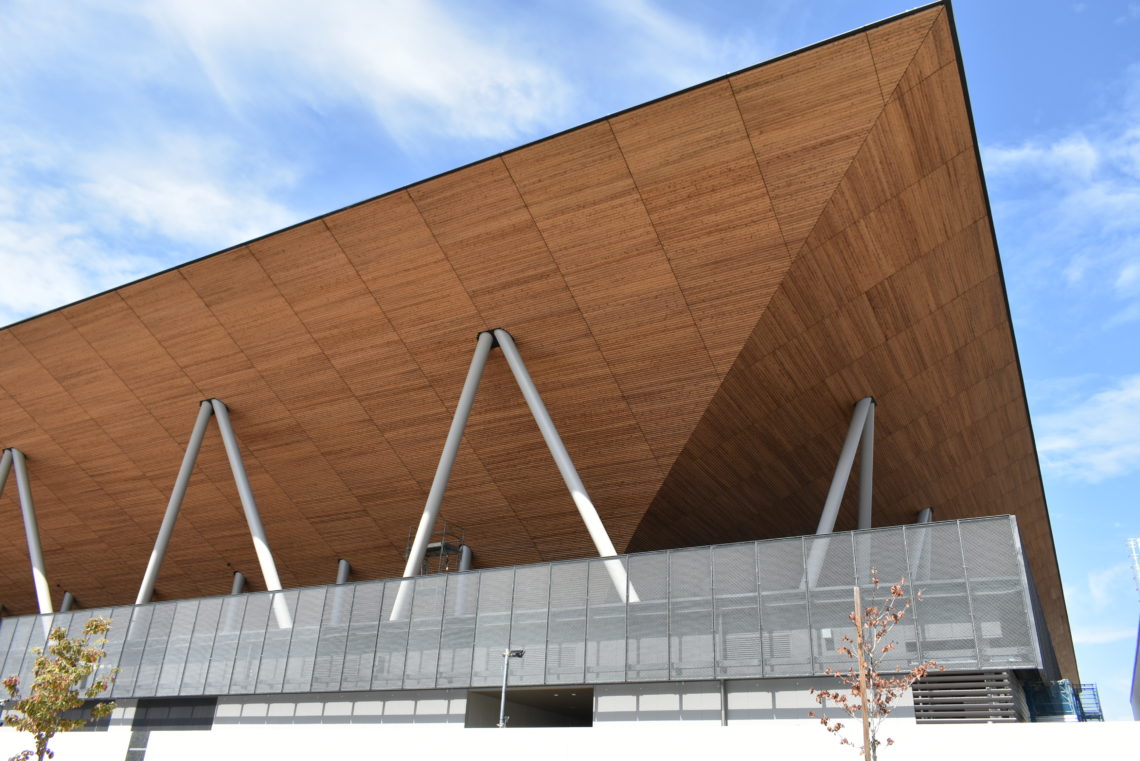
Conceived by Nikken Sekkei as “a wooden vessel floating in the Bay Area”, the arena for the Tokyo 2020 Olympics, Paralympics will now find new function as a permanent exhibition hall.
The streamlined Ariake Gymnastics Centre built for the recently concluded 2020 Tokyo Olympics and Paralympics Games boasts of one of the largest timber-framed roofs in the world spanning 90 metres, designed by Nikken Sekkei in collaboration with Shimizu Corporation. A riveting exercise in the use of natural materials, sustainable design and a reflection of the area’s history, the project was conceived for dual functions – initially as an emblematic, temporary international sports competition facility, and once the games got over, renewing and transforming into a permanent exhibition hall by removing the spectator stands. The wooden roof beams that crown the structure is free of any steel framework, which enabled the creation of the 30m high open expanse sans pillars in the venue’s centre.
Located in Ariake, Koto-ku in Tokyo, Japan, the unique arena has been conceived as “a wooden vessel floating in the Bay Area”, where a generous use of 2,300 cubic metres of sustainably sourced, warm timber essays an extensive role throughout the three-storey building. “This is a positive realisation of ‘wooded facilities’ and ‘sustainability’ announced in the Tokyo 2020 candidacy file,” the Japanese architects share. The venue also succeeds in effectively showcasing traditional Japanese craftsmanship, the structure resembling a floating ship embodying key aspects of Japan’s culture of timber-based construction.
“In 1964, when Japan was in rapid growth, the last Tokyo Olympic and Paralympic Games were held, and excellent sports facilities were built with concrete and steel. Today, as an equivalent to such legacies, we decided to make the most of wood, whose utilisation perhaps best protects the environment. Using timber also expresses the memory of this site, which used to be a timber storage pond. Timber is used in the roof structure, facades, spectator seats, exterior walls, and more, with careful consideration for the characteristics of wood in each application. All timber is certified material from domestically planted and sustainably managed forests, which ensure a sustainable circular environment,” they continue.
The Ariake Gymnastics Centre with a seating capacity of 12,000 is approached through a gently sloping entrance path made along the canal, utilising the excavated construction soil on site, with the imperceptibly arching roof in eyesight. The surface of the slope is covered with water-retentive waste-wooden chips that reduce the air temperature through evaporative cooling and is soft and comfortable to walk on. Deep timber eaves usher one into the structure, revelling in their rich, sculpted, and faceted characteristics. An instant feeling of weightlessness inside a warm membrane envelopes the visitor upon entering the arena, fully surrounded by the comforting hue of wood, with the structural timber frame of the huge ceiling looming protectively above and timber benches stretching leisurely below.
Redolent of the generous use of wood and recycled materials witnessed in Japanese architecture, the enormous wood-framed ceiling is designed specifically to reduce the weight of the overall structure, while the timber dressed facade considers properties of acoustic and thermal insulation. A corrugated steel roof shelters the structure, outlining the trapezoidal volume of the timber beams underneath to create the centre’s characteristic undulating shape. “Larch wood from Nagano and Hokkaido prefectures was used to create the timber roof. Cedar from Mie prefecture was used to craft the spectator benches, with cedar from Shizuoka, Miyazaki and Akita prefectures being deployed to create the large eaves,” states the official Olympics website.
Achieving beauty and richness in simplicity
Two years in the making, the project stretches in the middle of a wide-open landscape that rests along a canal and had to be mindful of the residential area full of medium and high-rise condominium buildings in the vicinity. Reaching a maximum height of 30 metres, the horizontal form was achieved to keep it as close to the ground as possible to avoid emerging as an overpowering form, minimising the overall volumes and controlling the height of the eaves.
Evocative of an engawa, a Japanese-style veranda, the expansive concourse space where the spectators enter the building has been intentionally placed in a semi-outdoor setting to generate seamless dialogue with the bayside. “My favourite element of the project is the external concourse area with the richness of the accumulation of the square timbers. We like it for its uniqueness in being an outdoor space that evokes the age-old traditions of Japanese wooden architecture, and that it brings a welcome breeze from across the canal,” says Hidemichi Takahashi, lead architect for the project. “By positioning the circulation concourse on the outside of the building and creating an open and broad approach, the design attempts to avoid the “impenetrable” exterior typically found on large-scale sports facilities created by monolithic walls,” he adds.
The wooden architecture is lent lightness with the use of the timber roof atop steel frames, which is effective for construction on sites with poor soil conditions. It is also Japan’s first complex structural system that uses timber beam strings structure and cantilever trusses to create the large spanning wood frame that dynamically covers the arena. Nikken Sekkei adopted a simple structure that employs single members of large glued laminated timber with high heat capacity, instead of trusses consisting of smaller members, to achieve both, fire resistance and structural stability.
When it comes to structural strength, wood is weaker than steel per cross-section area, yet stronger in compression strength-to-weight, the architects relay. “So, it is quite appropriate to use wood for the roof structure whose critical load is its own weight. One of the typical long-span structures using compression strength is the arch, which typically needs a bulky profile with a high rise. Hence, we contrived a complex structure with steel cables to cancel the thrust occurring with a low-rise timber arch beam without a steel frame in it and created a streamlined profile that blends into the vast open space of the Tokyo bay area,” Takahashi explains.
The Ariake Gymnastics Centre, located close to the Olympic Village, hosted Olympic artistic, rhythmic and trampoline gymnastic events, as well as Paralympic boccia. The main arena space, which will now become the primary exhibition hall was able to achieve a clear span of 88m by 117.6m, via low-profile laminated timber arches with cable structures fixed to cantilever trusses on either side. The arching profile of the roof was also designed to efficiently and effectively clear smoke in case of fire, making it easier for the filled space below to disperse quickly.
“Function, structure, and space are tightly combined to achieve beauty and richness in simplicity, which is the essence of Japanese traditional wooden architecture that we hope spectators and athletes from all over the world will experience and celebrate, even after the Tokyo 2020 Olympics conclude,” Takahashi shares. Be better, together – For the planet and the people, the underlying sustainability concept of the Tokyo 2020 Olympics was realised in full capacity and vigour with the Ariake Gymnastics Centre, along with other features and facets of the Games, delivering powerfully green solutions that responded head-on to global challenges of practically achievable sustainability in construction and design.
by Jincy Iype





